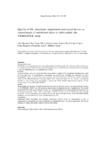Mostrar o rexistro simple do ítem
Quality of life, functional impairment and social factors as determinants of nutritional status in older adults: the VERISAÚDE study
| dc.contributor.author | Maseda, Ana | |
| dc.contributor.author | Diego-Díez, Clara | |
| dc.contributor.author | Lorenzo-López, Laura | |
| dc.contributor.author | López-López, Rocío | |
| dc.contributor.author | Regueiro-Folgueira, Laura | |
| dc.contributor.author | Millán-Calenti, José Carlos | |
| dc.date.accessioned | 2018-05-10T11:46:22Z | |
| dc.date.available | 2018-05-10T11:46:22Z | |
| dc.date.issued | 2017-04 | |
| dc.identifier.citation | Maseda A, Diego-Díez C, Lorenzo-López L, López-López R, Regueiro-Folgueira L, Millán-Calenti JC. Quality of life, functional impairment and social factors as determinants of nutritional status in older adults: the VERISAÚDE study. Clin Nutr. 2018;37(3):993-999 | es_ES |
| dc.identifier.issn | 0261-5614 | |
| dc.identifier.issn | 1532-1983 | |
| dc.identifier.uri | http://hdl.handle.net/2183/20697 | |
| dc.description.abstract | [Abstract] Background & aims. Malnutrition is an important and growing health problem in elderly people. The main aim of this research was to examine the relationship between socio-demographic factors, social resources, functional status and quality of life and malnutrition or risk of malnutrition in elders. Methods. A cross-sectional study was conducted with a representative sample of 749 community-dwelling elders aged 65 years and over. A comprehensive assessment was carried out, including the collection of socio-demographic factors, social resources by the Older Americans Resources and Services Scale, nutritional status by the Mini-Nutritional Assessment-Short Form, functional status by the Lawton's instrumental activities of daily living scale and quality of life by the World Health Organizations's Quality of Life measure-brief version (WHOQOL-BREF). Results. Being female, the presence of totally impaired social resources and low scores in the physical health domain of the WHOQOL-BREF were the strongest determinants of malnutrition/risk of malnutrition. This model predicted 85.7% of the cases correctly. In men, the best determinants were being unmarried and having poor satisfaction with their health, with a percentage of 89.8% of cases of poor nutritional status correctly predicted. The best determinant for women was also the physical health domain of the WHOQOL-BREF, reaching a correct prediction of 83.0% of malnutrition/risk of it. Conclusions. Nutritional status assessment and potential determinant factors should be incorporated as part of comprehensive assessments for early identification of malnutrition and to determine appropriate intervention strategies to address this public health problem in older adults. | es_ES |
| dc.description.sponsorship | Xunta de Galicia; EM 2012/100 | es_ES |
| dc.language.iso | eng | es_ES |
| dc.publisher | Elsevier | es_ES |
| dc.relation.uri | https://doi.org/10.1016/j.clnu.2017.04.009 | es_ES |
| dc.rights | Creative Commons Attribution-NonCommercial-NoDerivs 4.0 International License (CC-BY-NC-ND 4.0) | es_ES |
| dc.rights.uri | http://creativecommons.org/licenses/by-nc-nd/4.0/ | * |
| dc.subject | Malnourishment | es_ES |
| dc.subject | Undernutrition | es_ES |
| dc.subject | Mini nutritional assessment | es_ES |
| dc.subject | Elderly | es_ES |
| dc.title | Quality of life, functional impairment and social factors as determinants of nutritional status in older adults: the VERISAÚDE study | es_ES |
| dc.type | info:eu-repo/semantics/article | es_ES |
| dc.rights.access | info:eu-repo/semantics/openAccess | es_ES |
| UDC.journalTitle | Clinical Nutrition | es_ES |
| UDC.volume | 37 | es_ES |
| UDC.issue | 3 | es_ES |
| UDC.startPage | 993 | es_ES |
| UDC.endPage | 999 | es_ES |
Ficheiros no ítem
Este ítem aparece na(s) seguinte(s) colección(s)
-
GI-GIGG - Artigos [113]
-
INIBIC-IX - Artigos [31]






